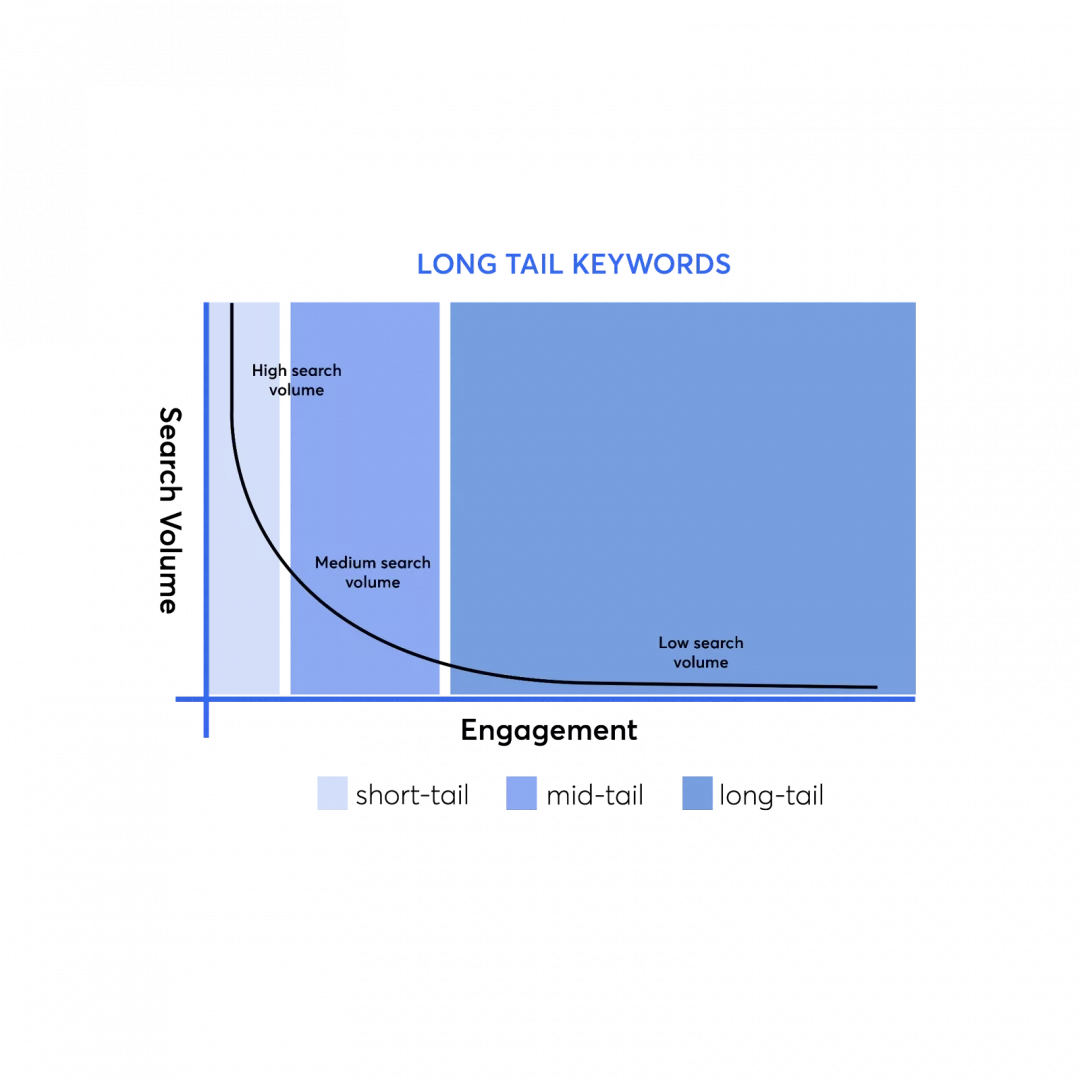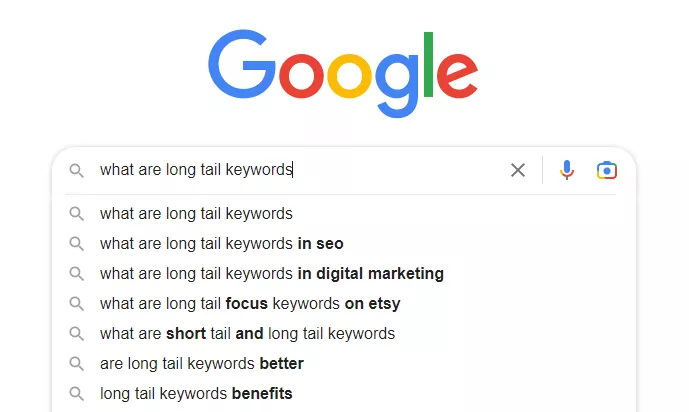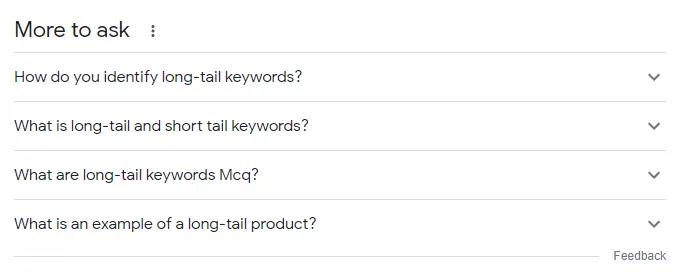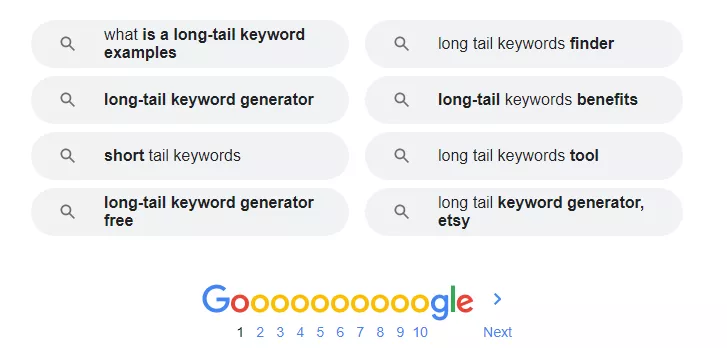What Are Long-Tail Keywords?
Long-tail keywords are longer and more specific search terms that have a smaller search volume than shorter keywords.
The term "long-tail" is believed to have originated in the field of SEO after Chris Anderson's book, "The Long Tail," or from the graphs in which these less common keywords occupy ample space and create a long tail.

Because long-tail keywords are more specific, they are less competitive but have a higher conversion rate compared to shorter keywords.
This quality of being less competitive leads to their lower search volume.
Example
The keyword "SEO" is too general and would face a lot of competition in digital marketing.
However, using a long-tail keyword such as "SEO optimization for local businesses" would reduce the search volume while increasing the specificity, creating a long-tail keyword.
More specific long-tail keywords like "best practices for on-page SEO optimization" or "SEO strategies for e-commerce websites" would have even lower search volume but higher specificity.
The choice of the most suitable long-tail keywords for your SEO strategy depends on the user's search intent and your niche.
It is essential to identify and target specific queries that align with your website's content and provide value to your target audience.
Why are they important?
Long tail keywords especially work well for those who have just stepped into their business and want it to be known. They are essential to a marketer for so many reasons.
Searcher's intent
Long-tail keywords are crucial because they help satisfy searchers' intent. By using specific and detailed long-tail keywords, your content becomes more relevant to what the searcher is looking for.
For instance, a general keyword like "shoes" would not satisfy the searcher's intent because it is too broad.
Instead, by narrowing it down to include details like type, quality, material, and colour, you can create more specific long-tail keywords that better match the searcher's intent.
This specificity makes your content more valuable to the searchers, increasing the chances of engagement, and conversion, as well as improving overall user experience.
Low competition
In the vast digital market, it is common for many people to adopt business ideas similar to yours, potentially outranking you before you even get started. So, using long-tail keywords is essential for standing out.
Long-tail keywords provide the specificity that helps your content rank higher in search results.
This is especially crucial when you are not running paid campaigns, as it can be challenging to compete for high-competition, short-tail keywords.
By using long-tail keywords, you can overcome high keyword difficulty scores and improve your chances of ranking for specific search terms.
Voice search
Voice search and typed search differ in the same way that a text message and a voice call differ.
When typing a search query, we don't use the same words as we do when speaking out loud.
Voice search is typically more detailed and conversational, making long-tail keywords particularly effective in this context.
For example, while you might type "weight loss tips" in a search bar, you might say "how can I lose weight" when using voice search.
This creates more opportunities for the use of long-tail keywords, which can be more specific and match the user's natural language.
High conversion rates
The ultimate goal of SEO is to drive conversions on your website.
This involves encouraging users to respond to calls-to-action, such as clicking the "Sign-Up", "Buy Now", or "Download" buttons.
Long-tail keywords can significantly improve your conversion rates because they are more specific and match the user's search intent.
A general product or service search may not necessarily lead the user to take action, whereas a long-tail keyword that aligns with their specific needs is more likely to inspire action.
Niche specific
Long tail keywords are niche specific –which gives you the advantage of bringing your product or service to a prominent position.
For example, “shoes” is an overly general keyword. Specifying it into subcategories like men’s shoes, leather shoes for men, or leather shoes for men with Velcro will make it more specific to your niche.
Low cost of CPC campaigns
Paid advertising campaigns for primary keywords can be costly due to the high competition.
However, campaigns that target long-tail keywords have a lower cost-per-click (CPC) compared to primary keywords.
This is because long-tail keywords have lower search volume and less competition, making them more affordable for paid campaigns.
Additionally, long-tail keywords have a higher chance of converting visitors into customers, which can ultimately lead to a better return on investment (ROI) for your advertising spend.
Shift into a more competitive market
By using long-tail keywords, you can position your business to compete in a competitive market even with primary keywords.
It is important to optimize your best pages, or the ones that best represent your business, for primary keywords.
Long-tail keywords can be used to guide users to these pivotal pages.
Internal linking is a useful tactic to direct traffic to the pages you want to rank higher in search results.
By incorporating relevant long-tail keywords and internal linking to direct users to your best pages, you can improve your overall SEO strategy.
The downside of long-tail keywords
While long-tail keywords offer many benefits for SEO, there are some downsides to consider.
One potential downside is that long-tail keywords typically have lower search volume than primary keywords.
Because of this, you need to optimize each webpage individually for specific long-tail keywords.
While this approach can lead to an equivalent search volume to a primary keyword, it does require extra effort and time to optimize each page.
It is important to prioritize which pages to optimize for long-tail keywords based on their relevance and importance to your business.
However, this additional task can be a challenge, particularly for larger websites with many pages.
Does search volume or length determine a long-tail keyword?
A long-tail keyword is determined by both search volume and length, but the primary factor is search volume.
Long-tail keywords are search queries with relatively low search volume, high specificity, and less competition.
They often consist of multiple words or phrases, which makes them longer than head or short-tail keywords.
However, it is the low search volume that truly characterizes a long-tail keyword, as it results in less competition and a more targeted audience.
Length can be a contributing factor, but it is not the sole determinant.
How to find long-tail keywords?
You can find them using Google or some valuable tools that efficiently find long-tail keywords.
Try Google
Google can suggest many long-tail keywords even as you start typing something into the search bar.
It can give you many options from which you can choose the relevant one.

If this does not work, you can try considering the suggestions in the “More to Ask” box. Also, this feature is helpful because you come to know the requirements of the user.

The “Related searches” section is another way to get ideas about your potential long-tail keywords. It will provide you with eight different ideas for making long-tail keywords.

Try tools
Tools can be more reliable and can save time.
SEMrush Topic Research Tool
The SEMrush Topic Research Tool is an invaluable resource for content creators, marketers, and SEO professionals who want to stay ahead of the competition by targeting long-tail keywords.

By simply entering the main keyword related to your niche, this powerful tool will provide you with the most relevant and popular search terms to focus on.
This can help you create targeted and engaging content that resonates with your audience and ranks higher on SERPs.
Google Keyword Planner
The Google Keyword Planner is a powerful and widely used tool designed to help advertisers and marketers with their keyword research and targeting for paid traffic campaigns.
By providing search volume data and predictions, this tool enables you to make informed decisions about the keywords you should target in your Google Ads campaigns.

To use Google Keyword Planner, sign in to your Google Ads account and navigate to "Tools & Settings".
Select "Keyword Planner" and choose the "Discover new keywords" option. Input your seed keyword and click "Get results".
Finally, analyze the resulting keyword data for search volume, competition, and suggested bids to optimize your campaigns.
Ahrefs’ Keyword Explorer
Ahrefs' Keyword Explorer is a powerful research tool that assists in discovering long-tail keyword phrases, which often have lower competition and higher conversion rates.
Access the tool by visiting the Ahrefs website and signing in to your account.
Navigate to the "Keyword Explorer" section from the main dashboard, enter your primary keyword or topic into the search bar and choose your target country.
Click the "Search" button to generate a list of related keywords.
Apply a filter to display keywords with low search volume, making it easier to identify valuable long-tail phrases.
Forums and social networking sites
Online forums and social networking sites such as Reddit and Twitter can provide valuable insights into user intent and popular topics through active discussions on various subjects.
By participating in or monitoring these conversations, you can gain a deeper understanding of your target audience's interests, needs, and pain points.
Takeaway
Long-tail keywords are longer, more specific phrases with lower search volume compared to shorter, more general keywords.
They are important to marketers as they satisfy searchers' intent, have low competition, are niche-specific, and are effective for voice search.
However, the downside of using long-tail keywords is that they require individual optimization for each webpage which requires extra effort and time.


